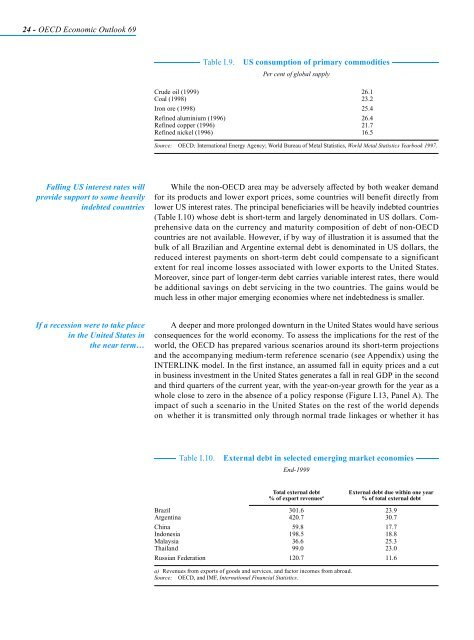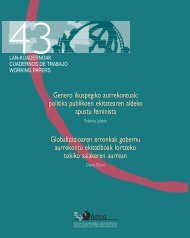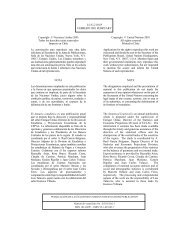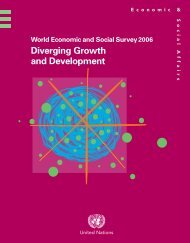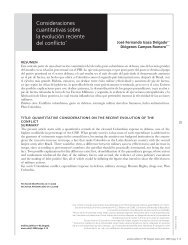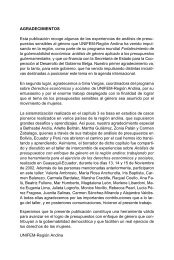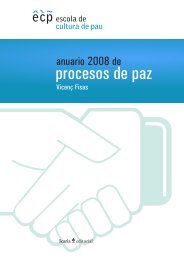OECD Economic Outlook 69 - Biblioteca Hegoa
OECD Economic Outlook 69 - Biblioteca Hegoa
OECD Economic Outlook 69 - Biblioteca Hegoa
Create successful ePaper yourself
Turn your PDF publications into a flip-book with our unique Google optimized e-Paper software.
24 - <strong>OECD</strong> <strong>Economic</strong> <strong>Outlook</strong> <strong>69</strong><br />
Falling US interest rates will<br />
provide support to some heavily<br />
indebted countries<br />
If a recession were to take place<br />
in the United States in<br />
the near term…<br />
Table I.9. US consumption of primary commodities<br />
Per cent of global supply<br />
Crude oil (1999) 26.1<br />
Coal (1998) 23.2<br />
Iron ore (1998) 25.4<br />
Refined aluminium (1996) 26.4<br />
Refined copper (1996) 21.7<br />
Refined nickel (1996) 16.5<br />
Source: <strong>OECD</strong>; International Energy Agency; World Bureau of Metal Statistics, World Metal Statistics Yearbook 1997.<br />
While the non-<strong>OECD</strong> area may be adversely affected by both weaker demand<br />
for its products and lower export prices, some countries will benefit directly from<br />
lower US interest rates. The principal beneficiaries will be heavily indebted countries<br />
(Table I.10) whose debt is short-term and largely denominated in US dollars. Comprehensive<br />
data on the currency and maturity composition of debt of non-<strong>OECD</strong><br />
countries are not available. However, if by way of illustration it is assumed that the<br />
bulk of all Brazilian and Argentine external debt is denominated in US dollars, the<br />
reduced interest payments on short-term debt could compensate to a significant<br />
extent for real income losses associated with lower exports to the United States.<br />
Moreover, since part of longer-term debt carries variable interest rates, there would<br />
be additional savings on debt servicing in the two countries. The gains would be<br />
much less in other major emerging economies where net indebtedness is smaller.<br />
A deeper and more prolonged downturn in the United States would have serious<br />
consequences for the world economy. To assess the implications for the rest of the<br />
world, the <strong>OECD</strong> has prepared various scenarios around its short-term projections<br />
and the accompanying medium-term reference scenario (see Appendix) using the<br />
INTERLINK model. In the first instance, an assumed fall in equity prices and a cut<br />
in business investment in the United States generates a fall in real GDP in the second<br />
and third quarters of the current year, with the year-on-year growth for the year as a<br />
whole close to zero in the absence of a policy response (Figure I.13, Panel A). The<br />
impact of such a scenario in the United States on the rest of the world depends<br />
on whether it is transmitted only through normal trade linkages or whether it has<br />
Table I.10. External debt in selected emerging market economies<br />
End-1999<br />
Total external debt<br />
% of export revenues a<br />
External debt due within one year<br />
% of total external debt<br />
Brazil 301.6 23.9<br />
Argentina 420.7 30.7<br />
China 59.8 17.7<br />
Indonesia 198.5 18.8<br />
Malaysia 36.6 25.3<br />
Thailand 99.0 23.0<br />
Russian Federation 120.7 11.6<br />
a) Revenues from exports of goods and services, and factor incomes from abroad.<br />
Source: <strong>OECD</strong>, and IMF, International Financial Statistics.


